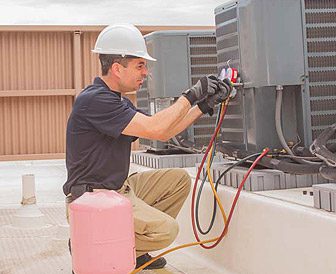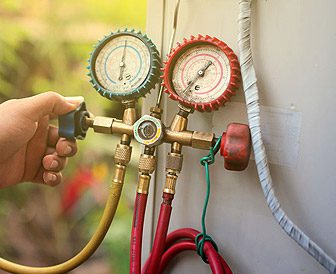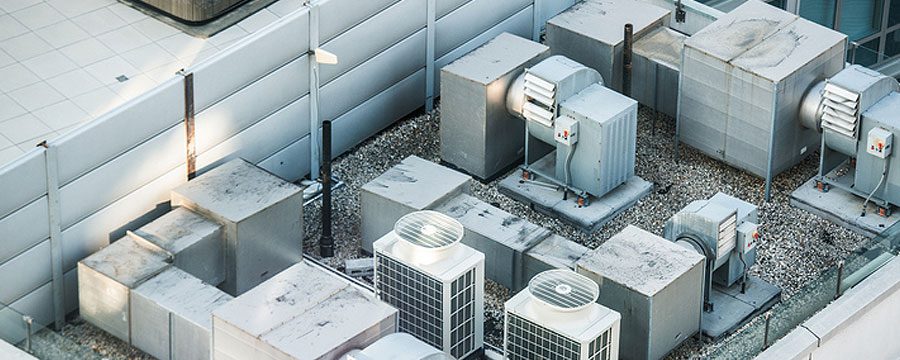In the scorching heat of summer, we all benefit from a working air conditioner. Having air conditioning units can be a literal life saver from high temperatures in some locations. The ease of accessing air conditioned places, whether at work, businesses, or home, in today’s developed world often leaves us taking the invention for granted…until something goes wrong with the machine, anyway.
Despite how common air conditioning is now, the modern air conditioner hasn’t been around for very long. Understanding the history of the air conditioner and the mechanics of how modern air conditioners work benefits the everyday homeowner and makes it easier for them to know the best way to maintain their own.
The History Of The AC
People have been trying to cool their living spaces since ancient times, but air conditioning as we know it has only been around since the early 1900s. Before that, ancient civilizations and then inventors in the 1700s and 1800s came up with their own methods for making living in hot temperatures bearable.
Air Conditioning’s Ancient Origins
While it’s hard to say exactly when humans decided to come up with ways to cool their homes, evidence shows some ancient civilizations tried their own air conditioning methods.
In ancient Egypt, wet cloth was hung in windows. When a breeze blew into the home, the air passed through the wet cloth, and the wet cloth would cool down the room to some extent.


Ancient China used giant fans that were worked by someone turning a hand crank. The air circulation helped cool the room. Sometimes these huge fans were placed by water fountains so that the moving air came in contact with the water, helping to cool things down even more.
As for ancient Rome, the wealthier citizens had aqueducts installed in the walls of their homes so that the running water worked to cool the inside.
The 1700s and 1800s Attempts at Air Conditioning Machines
Skipping forward in time, air conditioning ideas and inventions started showing up in the 1700s and 1800s.
1748, 1756: According to smithsonianmag.com, William Cullen, a well-loved professor at the University of Glasglow, created refrigeration technology by evaporating liquids in a vacuum. In his 1756 public demonstration of using a vacuum and diethyl ether, Cullen created a small piece of ice, but it wasn’t feasible at this time to use this technology for everyday use (historyofrefrigeration.com/refrigeration-invention/william-cullen/).
1758: Benjamin Franklin and Cambridge professor John Hadley gave a presentation similar to William Cullen’s, explaining how an object’s temperature could be lowered to freezing when inconstant liquids are evaporated on water’s surface (washingtonenergy.com/idea-center/air-conditioning-history-and-timeline).
1820 Michael Faraday successfully completed an experiment similar to that of Cullen’s, Franklin’s, and Hadley’s. The important difference is that he used ammonia, which later would be the first volatile liquid used in the modern air conditioning machine (washingtonenergy.com/idea-center/air-conditioning-history-and-timeline).
1830s-1851 Dr. John Gorrie’s foray into air conditioning came from his belief that high temperatures were bad for people’s health and diseases like malaria could be avoided in cooler temperatures. He also wished to make his patients more comfortable. His first idea of shipping in ice from frozen lakes was too expensive, so he looked into other ways he could cool areas. He ended up creating a machine that used a compressor powered by horse, steam, water, or wind sails to create ice (energy.gov/articles/history-air-conditioning). His invention is the first official air conditioning machine to be documented, and it could cool a room up to 20 degrees. It was used in hospitals, but never really took off in the marketplace (washingtonenergy.com/idea-center/air-conditioning-history-and-timeline).
Creator of the Modern Air Conditioner


Willis Carrier was a 25 year-old engineer tasked to solve a Brooklyn publishing house’s problem: the humidity of the area caused the pages of their publications to wrinkle and the print to blur, even when inside. How could this be avoided?
The idea came to him while he was watching the fog at a train station that passing dry air through water and creating a fog would make it possible to control how much moisture was left in the air. So, in 1902 Carrier filled steam coils with cold water and used an industrial fan to blow air over them. The humidity in the air condensed, sticking to the steam coils, and that resulted in humidity-free air that kept the publishing house’s magazines in good condition (carrier.com, energy.gov/articles/history-air-conditioning).
It also had the added benefit of cooling down a room since the air was cooled as a result of passing over the steam coils and their cold water.
Carrier dubbed his machine the “Apparatus for Treating Air” and continued to tinker with his invention to make it more efficient. At the time, his machine was huge and cost thousands of dollars. Eventually, in the 1920s, he came out with a better version of his machine that used dyeline instead of ammonia, making it safer to use (washingtonenergy.com/idea-center/air-conditioning-history-and-timeline).
Continuing Development of the Modern Air Conditioner
While Willis Carrier created the first modern air conditioner, the name came from another engineer: Stuart Cramer. Just a few years after Carrier’s invention, Cramer made a machine of his own that cooled the air and gave it the name we’ve come to associate with these cooling systems.
1932 saw the introduction of air conditioners that could fit on a window ledge. These more compact units were created by H.H. Schultz and J.Q. Sherman. Air conditioning still wasn’t mainstream though due to it still being costly.
That’s where Henry Galson’s contribution comes in. He invented a window air conditioner unit that was smaller and less expensive. It was on the market by 1947 (energy.gov/articles/history-air-conditioning).
What about air conditioners for vehicles? Well, we have Frederick Jones to thank for that. The African American man went on to create refrigeration systems that trucks and trains used to keep foods from spoiling during transport. He also invented a portable air conditioning unit for military camps during World War II, which were used for storing blood donations (lemelson.mit.edu/resources/frederick-jones).
How Air Conditioners Today Work
Air conditioners today work by using the same basic components as the ones in the early 1900s did. There is a compressor, compressor coils, coolant/refrigerant, evaporator coils, and a fan. Together, these parts remove the heat and humidity from the air inside.


Step One
The air conditioner sucks in the hot, inside air through a grille (usually at the bottom of the unit).
Step Two
The hot air then travels over the cold evaporator coils. These coils have the refrigerant inside, and they absorb the air’s warmth, leaving behind cool air. The heat from the air changes the refrigerant from a liquid to a gas.
Step Three
While a fan blows the resulting chilled air back into the room, the coolant starts its return from a gas state to a liquid state through the use of a compressor.
In accordance to its name, a compressor presses the refrigerant gas down into a very compact space. As a result of being so tightly contained, the refrigerant gas actually raises the gas’s temperature even more.
Step Four
The refrigerant gas is then moved to the condenser located on the part of the air conditioner exposed to outside. When it gets there, the outside air absorbs the gas’s heat and the refrigerant changes back to a liquid.
Step Five
The liquid refrigerant/coolant makes its way back to the evaporator coils, making them cold again.
The process then repeats until the inside air reaches the desired temperature and the air conditioner turns off.


Basic Air Conditioner Maintenance and Repairs
Knowing how an air conditioner works makes it a lot easier to figure out how to fix one if it breaks. Here are some things you can do yourself to increase the longevity of your air conditioner before calling in a costly professional.
Clean Your Air Conditioner’s Surfaces
One of the best and easiest things you can do to keep your air conditioner working properly is keep it clean. Cleaning the parts inside and outside your home prevents dirt, dust, and other debris from getting inside the unit and clogging things up.
Make sure to turn your AC unit off before trying any repair work.
Make Sure Your Thermostat is Working
If you think your air conditioner isn’t working, check your thermostat first. See if you can turn on your furnace. If you can’t, then the thermostat may be the problem. If you can, then you can be sure there is something wrong with the air conditioner itself.
Check the Air Filter
All air conditioners have air filters that either need to be cleaned or replaced every so often, depending on the brand. Dirty or clogged air filters are a common reason why air conditioners stop working as well as they did when first installed.
The air filter can be near your thermostat in the wall or in the air conditioner’s grille that faces the room. Simply remove the covering and take out the air filter to either clean or replace it.
Clean the Condenser Coils
It’s hard to keep everything and anything from getting into your AC unit parts meant to be outside. That’s why it’s good to check and clean around the compressor and condenser sections of your AC. With just a screwdriver and a wrench you can take off the exterior cage. Then, with either a cloth or vacuum, clean the insides.
Fix Coil Fins
Like the air filter, the state of your air conditioner’s coil fins determine how well air flows through your machine, and bad air flow means a less effective AC. They are part of the condenser (will be on the outside part of the unit) and look like thin, straight metal lines
Other Areas to Check
- See if drains are clogged (water may be leaking if this is the problem)
- Check for burnt fuses if the breaker works
- Look for refrigerant leaks
In Conclusion
People have been striving for a long time to keep their homes cool. However, it wasn’t until the early 1900s that machines were invented to make that possible. Thankfully, air conditioners today are a lot more accessible and affordable than when they were first created. Many of us rely on them for comfort and necessity depending on where we live. Because of that, knowing how an air conditioner works and basic maintenance and repairs allows us to enjoy this marvelous invention to the fullest.



